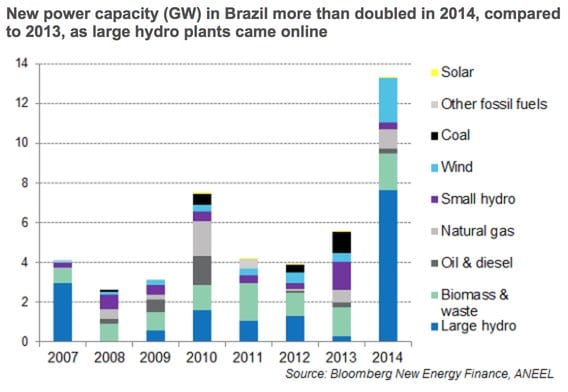While 2014 was a relatively upbeat year for the low-carbon sector, it ended with some caution in the air as share prices of clean energy companies retreated and Brent crude oil plunged.
The WilderHill New Energy Global Innovation Index, or NEX, which tracks around 106 clean energy stocks worldwide, lost 16.5% over the last six months of 2014. This decline compares with broader market indexes like the S&P 500, which rose about 5% over the same time period. Due to gains made earlier in the year, the NEX ended 2014 only 4.9% below 2013’s finish.
The most recent issue of Bloomberg New Energy Finance’s Clean Energy & Carbon Brief covers last quarter’s public market deals. BNEF will be releasing final figures for Q4 and 2014 later this week – these are likely to show that overall clean energy investment rose last year compared to the previous one.
Some market observers said that last year’s dip in clean-tech shares may have been an “emotional” response to the recent collapse of oil prices. Brent crude oil dropped more than 50% from $112.36/barrel on 30 June to $57.33/barrel at the end of the year. Since 1 January, Brent has continued to slip toward $50/barrel.
Bloomberg New Energy Finance has summarised its analysis of recent oil market movements here. The research company finds that if lower oil prices last, they are likely to slow the growth of the electric vehicle market, to some extent. Lower oil prices will also challenge the biofuels sector, which competes directly with oil as a transport fuel. However, in the US there is a volumetric mandate that ethanol must make up 10% of gasoline, so that underpins demand at current levels. In Brazil, ethanol has been competing against subsidised gasoline that sells at the pump for the equivalent of $65 per barrel, so the impact on ethanol from the oil price fall so far is likely to be small.
As far as the US gas market is concerned, this Analyst Reaction expects it will remain largely unaffected by crumbling oil prices. It points out that the current level of demand in the North American gas market makes the cost of supply insensitive to oil price movements. This will not be the case in Europe. Bloomberg New Energy Finance notes here that around half of Europe’s gas is supplied through long-term contracts, the majority of which is benchmarked to crude, so low oil prices translate directly into lower gas prices.
In policy news last week, Germany’s grid regulator announced it will lower solar subsidy payments by 0.25% per month for January to March after installations for the 12 months to November fell 43% on the same period in 2013, to 1,953MW. Bundesnetzagentur, the regulator, said that the target corridor is 2,400-2,600MW for solar.
The German PV market shrunk from 7.5GW installed in 2012 to under 2GW in 2014, as mentioned in the recent 2014 Germany Deep Dive. This decrease has been primarily due to subsidy cuts for all new systems and the imposition of a self-consumption tax for those larger than 10kW, mainly affecting PV systems built for the commercial sector.
The government has been trying to slow down the addition of PV since the surprise boom in PV in 2009 and 2010. Berlin aimed for 2.4-2.6GW of PV to be built every year between 2014 and 2020, a target that will be missed in its first year of existence. The renewable energy law requires that the subsidy be cut by 0.25% per month for the next quarter if its annual installation target is missed but more than 1.5GW are installed.
Finally, Vestas Wind Systems was keen to end 2014 with a bang as it announced 161MW of orders in Greece and Chile, putting the turbine maker on track to beat last year’s deals.
The Danish manufacturer announced 413MW of deals in the last three days of 2014. It is likely the company will announce that it has surpassed the previous year’s 5,964MW of orders when it details its earnings and unannounced orders from the last three months of the year on 11 February.
Greece’s Terna Energy placed a 73.2MW order for an onshore wind power project located on the uninhabited Agios Georgios island, off the coast of Attica, Greece. The order consists of V90-3.0 MW turbines and 14 V112-3.3 MW machines, Aarhus-based Vestas said in a statement on its website.
The turbines are due to be delivered in the third quarter of 2015 and the wind power plant is expected to start production by end of the year and be fully commissioned in the second quarter of 2016, the company said.
Vestas also won an order from an undisclosed Chilean customer for 44 V110-2.0 MW turbines, with a total capacity of 88MW, due to be completed in the first quarter of 2016, the company said in a separate statement on its website.
Vestas has now announced 5,864MW of new orders in 2014. The company noted on 30 December two US orders totalling 210MW, and the day before, it also listed a 42MW deal in Italy.











